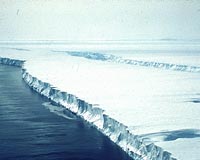| . |  |
. |
Paris, France (SPX) Dec 01, 2009 In the film, 'The Day After Tomorrow' the world enters the icy grip of a new glacial period within the space of just a few weeks. Now new research shows that this scenario may not be so far from the truth after all. William Patterson, from the University of Saskatchewan in Canada, and his colleagues have shown that switching off the North Atlantic circulation can force the Northern hemisphere into a mini 'ice age' in a matter of months. Previous work has indicated that this process would take tens of years. Around 12,800 years ago the northern hemisphere was hit by a mini ice-age, known by scientists as the Younger Dryas, and nicknamed the 'Big Freeze', which lasted around 1300 years. Geological evidence shows that the Big Freeze was brought about by a sudden influx of freshwater, when the glacial Lake Agassiz in North America burst its banks and poured into the North Atlantic and Arctic Oceans. This vast pulse, a greater volume than all of North America's Great Lakes combined, diluted the North Atlantic conveyor belt and brought it to a halt. Without the warming influence of this ocean circulation temperatures across the Northern hemisphere plummeted, ice sheets grew and human civilisation fell apart. Previous evidence from Greenland ice cores has indicated that this sudden change in climate occurred over the space of a decade or so. Now new data shows that the change was amazingly abrupt, taking place over the course of a few months, or a year or two at most. Patterson and his colleagues have created the highest resolution record of the 'Big Freeze' event to date, from a mud core taken from an ancient lake, Lough Monreach, in Ireland. Using a scalpel layers were sliced from the core, just 0.5mm thick, representing a time period of one to three months. Carbon isotopes in each slice reveal how productive the lake was, while oxygen isotopes give a picture of temperature and rainfall. At the start of the 'Big Freeze' their new record shows that temperatures plummeted and lake productivity stopped over the course of just a few years. "It would be like taking Ireland today and moving it up to Svalbard, creating icy conditions in a very short period of time," says Patterson, who presented the findings at the European Science Foundation BOREAS conference on humans in the Arctic, in Rovaniemi, Finland. Meanwhile, their isotope record from the end of the Big Freeze shows that it took around two centuries for the lake and climate to recover, rather than the abrupt decade or so that ice cores indicate. "This makes sense because it would take time for the ocean and atmospheric circulation to turn on again," says Patterson. Looking ahead to the future Patterson says there is no reason why a 'Big Freeze' shouldn't happen again. "If the Greenland ice sheet melted suddenly it would be catastrophic," he says. This study was part of a broad network of 38 individual research teams from Europe, Russia, Canada and the USA forming the European Science Foundation EUROCORES programme 'Histories from the North - environments, movements, narratives' (BOREAS). This highly interdisciplinary initiative brought together scientists from a wide range of disciplines including humanities, social, medical, environmental and climate sciences. Share This Article With Planet Earth
Related Links European Science Foundation (ESF) Beyond the Ice Age
 Antarctic melt may push sea levels to 1.4 metres: study
Antarctic melt may push sea levels to 1.4 metres: studyParis (AFP) Dec 1, 2009 Quickening ice loss in West Antarctica will likely contribute heavily to a projected sea level rise of up to 1.4 metres (4.5 feet) by 2100, according to a major scientific report released Tuesday. Scientists long held that most of Antarctica's continent-sized ice sheet was highly resistant to global warming, and that the more vulnerable West Antarctic ice block would remain intact for ... read more |
|
| The content herein, unless otherwise known to be public domain, are Copyright 1995-2009 - SpaceDaily. AFP and UPI Wire Stories are copyright Agence France-Presse and United Press International. ESA Portal Reports are copyright European Space Agency. All NASA sourced material is public domain. Additional copyrights may apply in whole or part to other bona fide parties. Advertising does not imply endorsement,agreement or approval of any opinions, statements or information provided by SpaceDaily on any Web page published or hosted by SpaceDaily. Privacy Statement |